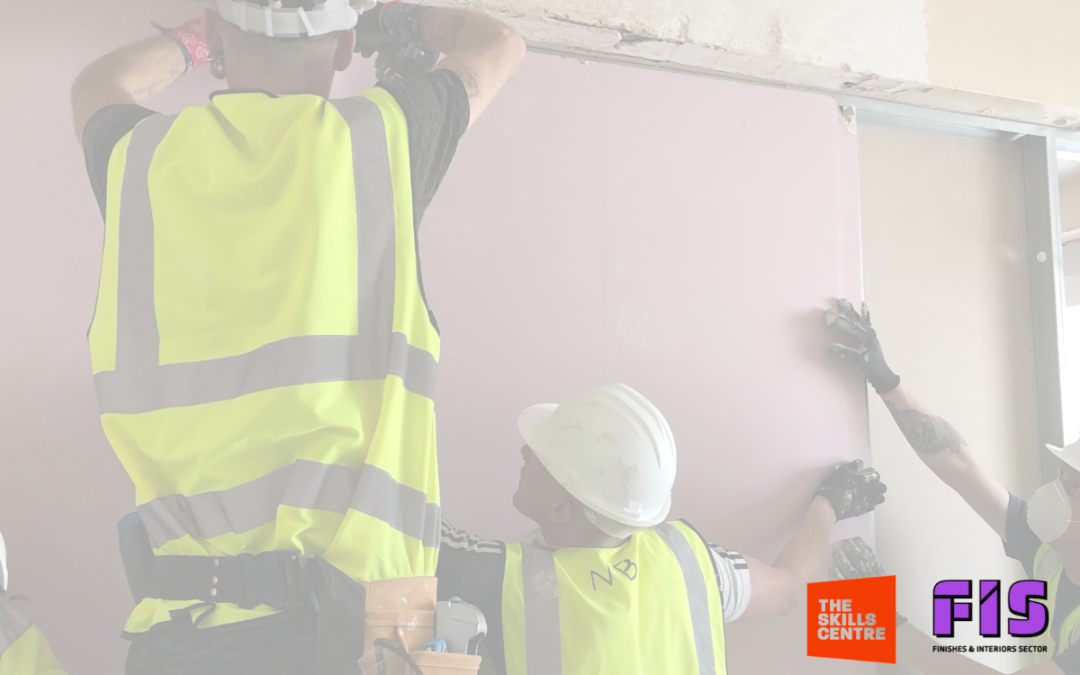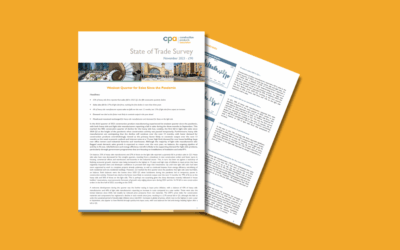
by Clair Mooney | 4 Mar, 2025 | Contractual and Legal, Payments
The Conflict Avoidance Coalition is launching a campaign to raise awareness of conflict avoidance and better dispute management. Conflict Avoidance Week 2025 is all about driving a cultural shift – fostering collaboration, cooperation, and communication across the construction industry. By raising awareness and sharing best practices, the Coalition wants to create:
- Stronger working relationships
- Smoother project delivery
- A more positive and productive work environment
Conflict Avoidance Week 2025 aims to highlight the importance of avoiding the time and expense associated with unnecessary disputes on construction and engineering projects. Instead, parties are encouraged to pursue resolution of issues through more collaborative efforts.
Conflict Avoidance Week will be officially launched on 24 March 2025 at an online event where delegates will hear from a range of industry professionals involved in conflict avoidance activities. You can register to join the launch event.
There will be an excellent line up of speakers, including FIS Chief Executive Iain McIlwee, our resident QS Len Bunton and Anthony Armitage from FIS member Thirdway to mention a few. They will be talking all things Pledge, highlighting upcoming activities, projects and plans, and showcasing real life conflict avoidance success stories.
The campaign encourages those associated with procurement and delivery of construction and engineering projects to commit to the Conflict Avoidance Pledge (www.capledge.org). Almost 600 organisations have signed the Pledge, indicating their commitment to maintaining business relationships and dealing with problems early and amicably. Businesses who have signed the Pledge have made this a keystone of their day-to-day commercial operations. Pledge signatories also commit to delivering value for money and working collaboratively to ensure projects are delivered on time, on budget and on par.
The Conflict Avoidance Coalition now comprises over 80 organisations, all associated with the procurement and delivery of construction and engineering projects. Participants include public and private sector clients, Tier 1 and Tier 2 contractors, trade organisations, and consultants.
The Week will be profiled via a range of events, maildrops, webinars and social media campaigns, all with a view to raising awareness.
Further information on Conflict Avoidance Week 2025, please contact the Coalition: CAPledge@rics.org

by Clair Mooney | 27 Feb, 2025 | CICV - Best Practice Guides, Contractual and Legal
Introduction
Ensuring prompt and full payment is critical to maintaining healthy cash flow in construction projects. This Practice Note provides best practices for preparing and managing payment applications to maximize your chances of getting paid on time and in full.
Once entitlement—such as for variations (as covered in Practice Note 4)—is established, the next challenge is securing payment. Many businesses fail to take a proactive approach to financial management, leading to cash flow problems and disputes.
This guide outlines key steps to streamline payment applications, minimize delays, and protect your financial position.
- Understanding Payment Terms and Cash Flow Impact
Before Signing the Contract:
Evaluate the impact of payment terms on your cash flow. If the terms are unfavourable, discuss alternative provisions with the Client.
Agree on a clear payment schedule before signing the contract. The schedule should specify:
- Application date
- Due date
- Final date for payment
- Deadlines for issuing payment and pay-less notices
Ensure the contract provides fair and realistic payment terms. If provisions do not align with your cash flow needs, negotiate adjustments.
- Submitting Payment Applications
Many disputes arise simply because payment applications are not submitted correctly or on time. Follow these steps to ensure compliance:
Know where to send applications. Some contracts require applications to be sent to both the Client’s/Contractor’s QS and another designated contact. Failure to comply may result in delayed or missed payments.
Use email tracking. Enable delivery and read receipts when submitting applications. Confirm that electronic submissions are accepted under the contract.
Follow contract format requirements. Ensure your application is detailed, clear, and well-documented, including:
- Quantities with supporting evidence
- Material and plant invoices
- Site instructions
- Photographic records
- Any other relevant back-up documentation
Tip: Many payment applications get rejected due to lack of supporting evidence. Make sure yours is comprehensive and meets the contract’s requirements.
- Follow-Up and Communication
Call the Client/Contractor QS after submission to confirm receipt and check if additional information is needed.
Send a follow-up email summarizing the discussion to document the status of the application.
Engage in proactive communication—don’t just rely on email; pick up the phone and discuss payment matters directly.
Before the contract begins, schedule a pre-contract administration meeting to ensure all financial procedures are agreed upon and documented.
- Managing Payment Delays and Non-Payment
If payment is not received by the final due date, you may have the right to suspend work until payment is made in full.
However, before suspending work, follow all contractual notice requirements carefully to avoid breaching the contract.
Monitor outstanding payments closely—do not allow unpaid invoices to accumulate.
Act quickly if payments are overdue. Many businesses let unpaid balances drag on, leading to serious financial strain.
Remember: It’s YOUR money. It should be in YOUR bank.
Final Advice
Understand your contract’s payment provisions before signing.
Submit applications correctly and on time.
Provide full supporting evidence to avoid rejections.
Follow up and communicate proactively.
Enforce your rights if payments are late, but always follow proper procedures.
By adopting these best practices, you can protect your financial position, improve cash flow, and reduce payment disputes in construction projects.

by Clair Mooney | 27 Feb, 2025 | CICV - Best Practice Guides, Contractual and Legal
Introduction
This Practice Note highlights the risks associated with variations in construction contracts, including onerous clauses, conditional precedents, and the risks of performing work without formal instructions. It builds upon Practice Note 1 on Notices and reinforces the importance of the “no instruction, no work” principle.
A key challenge for both contractors and subcontractors is completing work on-site only to face disputes over payment. This PN outlines how to identify and mitigate contractual risks related to variations, ensuring proper documentation and adherence to contract terms.
- Understanding Variations and Instructions
One of the most common clauses in subcontracts requires that all variations must be formally confirmed in writing. In many cases, failure to obtain a written variation order may result in the subcontractor having no entitlement to additional time or money.
How Variations Typically Arise:
- Site managers often issue verbal instructions on-site for additional work.
- Subcontractors, keen to progress the project, proceed without formal written approval.
- When the final account is settled, contractors dispute or reject the variation due to a lack of records or proper authorisation.
- Best Practices for Managing Variations
Step 1: Always Obtain Written Instructions
If a verbal instruction is given on-site:
- Request a formal site instruction (SI) in writing from the site manager.
Email the Contractor’s Quantity Surveyor (QS), seeking confirmation that it is a variation.
- Provide a cost estimate and request written approval before proceeding.
- If no written instruction is received, do not proceed unless the subcontract allows the subcontractor to issue a variation notice. If the contract requires written approval, failing to obtain it may mean the work will not be paid for.
Step 2: Clarify the Contractor’s Position
If the contractor refuses or delays issuing an instruction, this is a red flag and a potential dispute risk. In such cases:
- Explain that the contract requires written approval to avoid future disputes.
- If the contractor insists that work must start without a written instruction, escalate the issue immediately.
- Document the request and refusal for future reference.
- Keeping Accurate Records for Variations – refer also to PN 2
Maintaining proper records ensures variation claims are substantiated. The following records should be maintained:
- A log of all variation requests with request and response dates.
- A tracker for site instructions (SIs) received and whether they were in writing.
- Photographic and video evidence of the work before, during, and after completion.
- Labour, material, and time records for all additional work.
- Regular correspondence with the contractor’s QS to ensure agreement on variation costs.
Tip: Agree on variations as they occur rather than leaving disputes until the final account stage.
- Handling Disputes Over Variations
If an instruction is disputed, or if the contractor refuses to issue a variation order:
- Red flag the issue and document the request.
- Request an official instruction allowing the work to proceed, pending valuation under the contract.
- If no resolution is reached, consider alternative dispute resolution (ADR) options, such as the Conflict Avoidance Process (CAP), and the Low Value Adjudication Schemes.
- Readers should note however the provisions in the JCT and SBBC Contracts in Schedule Part 2, which relates to Clause 5.3 in the Contract, which allows for a Variation Quotation to be submitted, and this will include the direct loss and expense to be incurred. This brings cost certainty to the employer, and the contractor, and goes a long way to eliminate payment disputes.
- Final Advice
- Be proactive in managing variations — do not wait until the final account stage.
- Always insist on written instructions — verbal agreements are not enforceable.
- Keep detailed records — this will strengthen any claims for additional payment.
- Communicate regularly with the contractor’s QS — avoid last-minute disputes.
By implementing these best practices, contractors and subcontractors can ensure clarity, fair compensation, and effective commercial management while minimising disputes.

by Clair Mooney | 27 Feb, 2025 | CICV - Best Practice Guides, Contractual and Legal
Introduction
Contract amendments continue to be a major issue in the construction industry, often shifting risk disproportionately onto contractors and subcontractors. This Practice Note aims to highlight key contractual risks, explain why early contract review is essential, and provide guidance on managing amendments effectively.
For those new to the CICV Best Practice Guide (BPG), we strongly recommend reviewing its contractual and commercial management recommendations to reduce disputes and improve cash flow stability.
- Why Early Contract Review Matters
Many contractors fail to review contracts until it is too late. A common scenario is when a contractor only seeks a contract review the day before work starts—by then, it’s too late to renegotiate.
Review the contract at the tender stage to identify risks early.
If amendments are unreasonable, negotiate or price the risk accordingly.
If the contract terms are unacceptable and non-negotiable, be prepared to walk away.
Tip: Some industry bodies, such as the Finishes and Interiors Sector (FIS), offer Contract Review Services to help members identify high-risk clauses before signing.
- Common Risk Areas in Contract Amendments
Below are some of the most problematic contract amendments contractors should watch for:
Payment Terms
- Amendments that delay payments beyond standard terms.
- Retention clauses that extend payment periods or increase retention percentages.
Notice Provisions
- Onerous “time-bar” clauses requiring notification of delays within a very short timeframe (e.g., 2-7 days).
- Strict notice requirements for submitting claims—refer to Practice Note 1 (PN1) on Notices for details.
Liquidated & Ascertained Damages (LADs)
- LAD amounts that are disproportionate to the subcontract value.
- No clear cap on liability, exposing subcontractors to excessive financial penalties.
Practical Completion
- Does the subcontract have its own completion date, or is it tied to the main contract completion?
- Are there unfair dependencies on other contractors’ work?
Variations and Design Responsibility
- Unclear variation procedures—refer to Practice Note 4 (PN4) on Variations for best practices.
- Expansion of Contractor Design Portions (CDP), shifting design liability to subcontractors.
- No clarity on interface issues with other trades or contractors.
Site Conditions and Title Issues
- Clauses that pass responsibility for ground conditions or existing buildings to the contractor.
- Unclear responsibilities for resolving title issues or dealing with external utility providers.
Insurance Requirements
- Contractual insurance provisions that do not align with your actual policies.
Design liability clauses that may not be covered under your Professional Indemnity (PI) insurance.
- How to Manage Unfavourable Amendments
If you encounter onerous contract amendments, you have three options:
- Negotiate the terms with the client/contractor. Many amendments can be modified if raised early.
- Price the risk—factor potential liabilities into your tender pricing.
- Reject the contract and walk away if the risks are too high.
Tip: Industry bodies and trade organisations can provide support if you face unreasonable contract terms.
- Industry Response and Conflict Avoidance
The construction industry is increasingly concerned about excessive contract amendments. The Conflict Avoidance Coalition is actively working with industry experts to address unfair practices.
If you are seeing highly unfair or unworkable contract amendments, reach out to your trade body or the Conflict Avoidance Coalition for support.
For further insights, watch the Cash Flow and Contract Webinar on the CICV website.
Final Advice
Always review contracts before signing—never wait until work is about to start.
Understand your obligations and risks—identify clauses that could impact your cash flow.
Engage in early discussions—negotiate terms that protect your interests.
Seek expert advice—use industry contract review services if needed.
Taking a proactive approach to contract amendments will help mitigate risk, reduce disputes, and improve financial stability.

by Clair Mooney | 27 Feb, 2025 | Awards, Main News Feed
FIS announced the winners of its 2025 Innovation Awards at a ceremony held at is Conference in London on 26 February.
In front of a live audience at the Business Design Centre, the winners of the FIS Innovation Awards were announced and presented. The Awards recognise and celebrate innovation in the finishes and interiors sector showcasing companies that are paving the way for greater efficiency and collaboration. The awards comprised three categories: Product, Digital and Sustainability.
All entries were independently assessed by a panel of expert judges and the winner of each category was announced in front of a live audience. The winner of each category was then invited to deliver a short pitch on their innovation to the audience, who then determined the overall 2025 Innovation of the Year winner.
The 2025 award winners are:
Innovation of the Year
XFrame for its circular build solutions
Digital
Circuland for its Circuland platform to enable material re-use
Product
Architectural Wallsz for its fire rated back-to-back headwall
Sustainability
XFrame for its circular build solutions
The awards and event were supported by sponsors Troldtekt, Procore, Simonswerk, Forza Doors, Plus Finance and SpecFinish

by Clair Mooney | 21 Feb, 2025 | Market data
Workloads reported by FIS members in the FIS State of Trade Survey for the final quarter of 2024 were mixed with just over a quarter of respondents (26%) reporting no changes and 23% seeing an increase of over 5%.
Reports of sales volumes showed that 30% of respondents saw an increase of over 5% quarter-on-quarter and looking to the next quarter (Q1 2025) the expectation for most is very positive with 60% anticipating a growth of over 5%.
Labour availability is the second highest reported factor most likely to constrain output next year (23%) with demand as the highest reported by 45%.
FIS members can access the full findings here.

by Clair Mooney | 21 Feb, 2025 | Skills
Construction trades students at Southall Community College (West London Collegeare looking for employers interested in supporting a one-week work experience placement starting on Monday 3 March 2025.
The first years’ students have completed their health and safety units and basic processes including using tools and access equipment, understanding fabrication and installation processes and materials in the workplace.
The second years students have gained additional knowledge and more intricate workshop skills in their chosen trades (Brickwork / Carpentry and Joinery / Electrical Installation /Plastering / Drylining / Plumbing and Heating / General Operative / and Motor Vehicle.)
Students’ postcodes are representative of all London boroughs (we hope to match your S106 requirements). They are either 16-18 or 19+ of age. They will have their own PPE boots. Most do not have their CSCS card yet but have good knowledge of the H&S requirements on site.

by Clair Mooney | 20 Feb, 2025 | Skills
FIS in partnership with CITB and industry experts, have developed comprehensive Competence Frameworks that outlines the training and qualification landscape and the essential Skills, Knowledge, Experience, and Behaviours for operatives and installers of Raised Access Flooring, Operable Partition Systems and Ceiling Installation.
These webinars offer a unique opportunity to explore the frameworks and contribute your insights through a wider review and feedback session. Your feedback is invaluable in helping to shape the future of these professions. Don’t miss your chance to influence the standards that will define the future of these occupations. You can register for each webinar via the links below.
Raised Access Flooring – 10 March 2025, 2pm
https://www.eventbrite.co.uk/e/1246300591619?aff=oddtdtcreator
Operable Partition Systems – 11 March 2025, 2pm
https://www.eventbrite.co.uk/e/operable-partition-systems-competence-framework-tickets-1249189141349?aff=oddtdtcreator
Ceiling Installation – 13 March 2025, 2pm
https://www.eventbrite.co.uk/e/competence-framework-ceiling-installation-tickets-1252932527919?aff=oddtdtcreator

by Clair Mooney | 20 Feb, 2025 | CICV - Best Practice Guides, Contractual and Legal, Main News Feed
This Practice Note is a supplement to Practice Note 1 ‘Notice’, aimed at highlighting key specific notice provisions under NEC3 & 4 Engineering and Construction Contracts (‘ECC’) and the NEC3 & 4 Engineering and Construction Subcontract (‘ECS’).
Specific Situations Requirement Notices
Contractors and subcontractors should be aware that generally, NEC contracts contain notice provisions in respect of the following situations:
- Compensation Events.
- Early Warning.
- Defects.
- Ambiguities and inconsistencies.
- Illegal and impossible requirements.
- Prevention.
- Termination.
A brief overview these provision is as follows:
NEC3 & 4 (ECC)
Compensation Events
- The Project Manager notifies the Contractor of compensation events arising from an instruction, the issue of a certificate, the changing of an earlier decision, or a correction of an assumption (cl.61.1).
- The Contractor notifies the Project Manager of an event the Contractor believes to be a compensation event that has not been notified by the Project Manager (cl.61.3).
- The Project Manager notifies the Contractor if the Project Manager decides that an event notified by the Contractor is not a compensation event (cl.61.4).
- When requesting a quotation from the Contractor, the Project Manager notifies the Contractor if the Project Manager decides the Contractor failed to issue an early warning notice (cl.61.5).
- If the effects of a compensation event cannot be reasonably ascertained with certainty, then, in an instruction to provide quotations, the Project Manager states any assumptions made by the Project Manager concerning the effects of a compensation event (cl.61.6).
Early Warning
- The Project Manager and the Contractor notify each other as soon as they become aware of any matter which could increase the total of the Prices, delay Completion, delay meeting a Key Date, or impair the performance of the works in use (cl.16.1[NEC3] / cl.15.1[NEC4]).
Defects
- Up to the defects date, the Supervisor and the Contractor notify each other of Defects as soon as they find them (cl.42.2[NEC3] / cl.43.2[NEC4]).
Ambiguities and Inconsistencies
- The Project Manager or the Contractor notify each other as soon as they become aware of any ambiguity or inconsistency in or between the contract documents (cl.17.1).
Illegal and Impossible Requirements
- The Contractor notifies the Project Manager if the Contractor believes the Works Information [NEC3] (or ‘Scope’ as per the NEC4) requires him to do anything illegal or impossible (cl.18.1[NEC3] / cl.17.2[NEC4]).
Prevention
- If an event occurs, which neither Party could prevent, that stops the Contractor from completing the works by the date shown on the Accepted Programme, the Project Manager notifies (instructs) the Contractor on how the event is to be dealt with (cl.19.1).
Termination
- If either Party wishes to terminate the Contractor’s obligation to Provide the Works, the Party wishing to terminate notifies the reason to the Project Manager and the other party (cl.90.1).
NEC3 & 4 (ECS)
Compensation Events
- The Contractor notifies the Subcontractor of compensation events arising from an instruction, the issue of a certificate, the changing of an earlier decision, or a correction of an assumption (cl.61.1).
- The Subcontractor notifies the Contractor of an event the Subcontractor believes to be a compensation event that has not been notified by the Contractor (cl.61.3).
- The Contractor notifies the Subcontractor if the Contractor decides that an event notified by the Subcontractor is not a compensation event (cl.61.4).
- When requesting a quotation from the Subcontractor, the Contractor notifies the Subcontractor if the Contractor decides the Subcontractor failed to issue an early warning notice (cl.61.5).
- If the effects of a compensation event cannot be reasonably ascertained with certainty, then, in an instruction to provide quotations, the Contractor states any assumptions made by the Contractor concerning the effects of a compensation event (cl.61.6).
Early Warning
- The Contractor and the Subcontractor notify each other as soon as they become aware of any matter which could increase the total of the Prices, delay Completion, delay meeting a Key Date, or impair the performance of the works in use (cl.16.1[NEC3] / cl.15.1[NEC4]).
Defects
- Up to the defects date, the Subcontractor and the Contractor notify each other of Defects as soon as they find them (cl.42.2[NEC3] / cl.43.2[NEC4]).
Ambiguities and Inconsistencies
- The Subcontractor or the Contractor notify each other as soon as they become aware of any ambiguity or inconsistency in or between the contract documents (cl.17.1)
Illegal and Impossible Requirements
- The Subcontractor notifies the Contractor if the Subcontractor believes the Works Information [NEC3] (or ‘Scope’ as per the NEC4) requires him to do anything illegal or impossible (cl.18.1[NEC3] / cl.17.2[NEC4]).
Prevention
- If an event occurs, which neither Party could prevent, that stops the Subcontractor from completing the works by the date shown on the Accepted Programme, the Contractor notifies (instructs) the Subcontractor on how the event is to be dealt with (cl.19.1).
Termination
- If either Party wishes to terminate the Subcontractor’s obligation to Provide the Subcontract Works, the Party wishing to terminate notifies the reason to the other party (cl.90.1).
Final Advice
In the management and administration of NEC contracts, parties have the opportunity to act promptly and issue notices in accordance with a wide variety of contractual provisions. This not only aids in avoiding disputes by maintaining communication but also ensures certainty regarding the correct contractual position, which directly contributes to, or even governs, robust commercial management and financial outcomes.
Additional guidance notes

by Clair Mooney | 20 Feb, 2025 | CICV - Best Practice Guides, Main News Feed
This Practice Note is the second in a series designed to enhance commercial management in construction projects by promoting best practices for record-keeping. Authored by experienced consultants Len Bunton, Sean Bradley, and Mark Holden-Smith, it outlines key recommendations from the CICV Best Practice Guide (BPG) to help subcontractors and contractors safeguard their contractual position.
The Importance of Record-Keeping in Construction Contracts
One of the most common mistakes contractors make is failing to maintain comprehensive records of contract events. These records become crucial if a contractual claim arises or if an employer seeks to impose liquidated damages.
As highlighted in Practice Note 1, ensuring that contractual notices are issued in compliance with the agreement is fundamental. This is particularly important when pursuing claims for extensions of time or loss and expense, as failure to provide proper notice may invalidate a claim.
A recurring issue in construction disputes is the loss of project knowledge when key personnel—such as site managers, contracts managers, or commercial managers—leave their roles. Additionally, poor management of electronic files, including missing or deleted documents, can create significant challenges. To mitigate these risks, all project records should be securely stored and readily accessible from the outset of the contract.
Key Records to Maintain
To ensure robust documentation, contractors should retain the following records:
- Essential Contract Documentation
- All tender documents.
- Emails and electronic communications (both inbox and outbox).
- Hard copies of key correspondence (recommended for larger projects).
- Meeting and Site Documentation
- Pre-start meeting minutes.
- Progress meeting minutes.
- Meeting records with subcontractors.
- Project Execution Records
- Site diaries documenting daily progress.
- Site instructions.
- Requests for Information (RFIs) with a tracker showing request dates and response times.
- Records of variations to the contract.
- Construction drawings and a maintained drawing register.
- Programme Management
- Tender programme.
- Contract programme and any progress updates.
- As-built programme (critical for extension of time claims).
- Additional programming documentation.
- Defects and Quality Control
- Snagging lists.
- Defect resolution records, including dates of client acceptance.
- Visual Evidence
- Weekly photographs with date stamps and annotations.
- Video recordings of progress and site conditions (helmet-mounted camera systems can be used to document delays, disruptions, and inaccessible areas).
- Subcontractor Documentation
- Ensure that all subcontractors also maintain detailed records, as their support may be needed for claims.
Consequences of Poor Record-Keeping
Failure to maintain adequate records can severely undermine a contractor’s ability to:
- Pursue contractual claims (e.g., extension of time, loss and expense).
- Defend against employer allegations (e.g., delays, defective work).
- Support adjudication or legal proceedings, as weak documentation reduces the likelihood of success.
Without clear and comprehensive records, a contractor pursuing an adjudication may face:
- Unsuccessful claims due to lack of evidence.
- Liability for adjudicator and consultant fees.
- Serious financial repercussions for the business.
Final Advice
“If you fail to prepare, then prepare to fail.”
Proper record-keeping is not just an administrative task—it is a critical business safeguard. By following these best practices, contractors can improve project management, avoid disputes, and ensure contractual compliance.
You can access the full guide here
Additional guidance notes

by Clair Mooney | 18 Feb, 2025 | Employment
Recruitment challenges are at an all-time high, with businesses facing talent shortages, rising competition, and changing workforce expectations. To help employers overcome these obstacles, our Associate Service Provider Member Citation has developed an expert-written Recruitment & Retention Guide packed with practical strategies and legal insights.
This guide includes:
- Where to advertise your vacancy
- Job interview question examples
- How to develop a proper induction process
- Tips to keep your people happy and engaged
Whether you’re hiring now or planning for the future, this resource is essential for staying ahead in today’s job market. Download your free copy here: https://tinyurl.com/4zta5e3v
If you’d like to chat about how Citation can help with the HR and Health & Safety side of your business, just give them a call on 0345 844 1111, or fill in their call-back form, and they’ll get right back to you. Remember to quote ‘The Finishes and Interiors Sector’ when enquiring to access preferential rates.

by Clair Mooney | 14 Feb, 2025 | Drylining, Employment, Skills
Construction training provider, The Skills Centre has launched a cutting-edge apprenticeship scheme specialising in drylining.
Designed in collaboration with employers and endorsed by FIS, this specialist training programme will launch in March at The Skills Centre’s new green skills training facility in Edgware, run in partnership with Ballymore, Places for London and Barnet Council. The programme will then expand to The Skills Centre’s Build East facility at The Queen Elizabeth Olympic Park and into a new custom facility in Essex later this year.
With demand for new housing, the need to upgrade buildings across the UK to help optimise space and deliver net-zero emissions by 2050, demand for interior systems, insulation and retrofit skills is surging. Yet, the industry faces a critical shortage of trained professionals. Our new interior systems and drylining apprenticeship will help bridge this gap by equipping learners with some of the essential skills required to meet these targets. An estimated 3.4 million properties in London alone require retrofitting, and with 78% of construction employers reporting retrofit skills shortages, this training is timely and essential.
The drylining apprenticeship training will cover:
- Partition Walls
- MF Ceilings
- Grid Ceilings
- Shaft Walls
- Metsec Installation
- Rainscreen Cladding
- Passive Fire Protection
Apprentices will gain additional qualifications in:
- NVQ L2 Interior Systems
- PASMA
- CSCS
- SSSTS (if eligible)
This apprenticeship is open to those seeking to build a successful career within the construction sector, providing the skills, knowledge, and behaviours necessary to establish a strong foundation in the industry.
Supporting employer recruitment: To assist employers with recruitment, The Skills Centre offers 8-week interior systems bootcamps for new entrants. These bootcamps provide a mix of classroom and practical training, including CSCS Green Card, and allow employers to meet pre-screened candidates and conduct two-week trial placements before committing to an apprenticeship hire. This provides companies with access to a pipeline of engaged, local candidates equipped with the relevant skills to excel in the apprenticeship programme from day 1.
Jon Howlin, CEO of The Skills Centre, said:
“Recruiting quality candidates has been a significant challenge for many in the construction industry. Our apprenticeship and bootcamp programmes are designed to alleviate this by providing a vital pipeline of skilled, local talent ready to meet the industry’s evolving demands.
“The Skills Centre is committed to collaborating with employers and construction companies to ensure that local people have access to opportunities in the industry and that our partners receive the skilled workforce they need for their projects.”
While the Interior Systems Apprenticeship is a new addition to The Skills Centre’s delivery, they have been providing apprenticeships in Groundwork, Formwork, Steel Fixing and Highways Maintenance for several years, and recently received a Good overall grade from OFSTED with Outstanding marks for Adult Education Provisions.
FIS CEO Iain McIlwee added:
“Employers want people, people want jobs that allow them to earn and develop and government want a productive workforce, yet we seem to make it complicated and consistently fail to meet the expectations of each other.
“It is refreshing to be working so closely with The Skills Centre to rethink the way that we put it all together and deliver a programme that can work for everyone. Flexible, practical and quality provision, tailored to employer need in an environment that supports the individuals is what this is all about. Plugging in the Bootcamps makes sense too, it means employers and individuals can start the process, help people get productive early and ensure that we are investing in the people that want to and will be able to carve a career out in our industry with full knowledge of what that is before the serious investment starts. The next 5 years is going to see major reform of the apprenticeship model and this is a fabulous way to kick that off in the finishes and interiors sector”.
The Skills Centre are working with a number of employers to support both the Bootcamp and the Apprenticeship, including Measom, one of the leading Drywall Contractors in the UK and an integral part of the construction industry.
Rikki Wild, Training Manager at Measom said,
“Creating clear and accessible entry points into the dry lining industry is crucial for its long-term success, and this programme achieves just that. By combining intensive bootcamps with structured apprenticeships, we are offering a comprehensive pathway for new talent to enter the sector, providing them with the essential skills and knowledge from the very start. At Measom, we recognise the great value of practical, employer-led training that ensures apprentices are fully prepared and confident when working on-site. This initiative plays a key role in helping employers like us develop a highly skilled, adaptable, and sustainable workforce, which is vital to meeting the future needs and challenges of the industry.”
To learn more about this apprenticeship opportunity or to apply, visit https://theskillscentre.co.uk/courses-services/interior-systems-installer-dry-lining-apprenticeships.

by Clair Mooney | 14 Feb, 2025 | Contractual and Legal
FIS is working with legal expert Sarah Fox (famous for her 500-word approach to contracts) to create a simplified subcontract for FIS members to use.
Sarah describes herself as a recovering lawyer and her work is driven by the principle that we are wasting time, money and energy on paperwork that few users can understand. Complex contracts and unclear processes are costing our sector profit, deals and relationships.
This very much chimes with the challenges that were identified in the Reading Report. Sarah has spent 10 years putting her idea into practice and drafting UK construction contracts starting with just 500 words. At the heart of her work is a simple idea – simplification works. When you streamline deals and clarify terms you’ll save avoid conflict, sign deals quicker and be more efficient.
To kick us off, FIS is looking at drawing together an intrepid group of contractors who regularly sub-contract packages of work (as distinct from using Labour Only Sub Contractors to deliver work they are contracted to do) to develop a universal contract that will be available for all members to use. Our aim is to develop this contract in a 2-hour online workshop.
If you are interested in getting involved, please email: iainmcilwee@thefis.org by 21 February 2025.
If you have any live legal issues or want advice around standard form contracts, don’t forget the FIS Legal and Contractual Toolkit is available here and has a raft of tools to support the FIS Community.

by Clair Mooney | 10 Feb, 2025 | Main News Feed
FIS is delighted to announce the appointment of Damian Hill to the newly created role of Technical Projects Manager, following the retirement of its Technical Director Joe Cilia. A seasoned professional with over 30 years of experience in the interiors sector, Damian brings a wealth of technical knowledge and leadership to FIS during an exciting time of transformation.
As part of this transition, Jim Parlour has been promoted to Head of Technical, progressing from his previous position as Technical and Vetting Manager. These changes form part of FIS’s commitment to evolve and expand its technical support services for the £10 billion finishes and interiors sector.
In his new role, Damian will play a pivotal role in supporting FIS as the leading technical authority for the finishes and interiors sector. His primary responsibilities will include managing technical projects, collaborating with the FIS team, members, and external stakeholders to enhance and update technical resources, and ensuring that FIS continues to deliver high-quality technical guidance, training, and support for the sector.
“I am absolutely delighted to be joining FIS and look forward to working with the exceptionally talented team and all members of this amazing sector,” said Damian Hill. “Having spent 30 years within the interiors industry, I am excited to bring my knowledge, experience, and passion to continue the great work FIS does for its members in promoting quality, collaboration, innovation, safety, and best practice.”
Hill’s extensive background in the interiors industry includes 24 years at SIG, where he held various roles across sales, business development, and training in core interior products. Most recently, as Ocula Partitions Technical and Training Manager since 2018, he has overseen product development, performance testing and certification, compliance, and systems training. Hill has also been an active member of the FIS Partitions and Pods Working Group, staying up-to-date on the latest developments and providing valuable insights to help shape the future of the sector.
Commenting on the new role, Jim Parlour, Head of Technical at FIS, said:
“Damian brings a wealth of experience as a technical communicator, having provided functional training to hundreds of staff in all interior construction product disciplines. We are looking forward to accelerating our development of the FIS e-learning platform, advancing competence standards for estimating, procurement, and design functions, as well as receiving project management support for all our technical activities and membership vetting efforts.”
The addition of Damian Hill to the FIS leadership team, alongside Jim Parlour’s promotion, marks a key step in FIS’s efforts to enhance its technical support and resources for the finishes and interiors sector.

by Clair Mooney | 6 Feb, 2025 | Awards, Main News Feed
FIS has announced the shortlist for its 2025 Innovation Awards. The awards aim to shine a light on innovation, debunking the myth that our sector is not innovative. The Awards comprise three categories, Digital, Sustainability and Product. A judging panel was set up for each category, who indpendently assesed all entries.
Digital
- Chalkstring for its cloud-based cost management software platform, Chalkstring
- Circuland for its an AI-powered platform, Circuland
- Material Index for its digital reuse platform
Sustainability
- F&T Terrix for its Spray Plaster and Paint System
- The Pallet LOOP and British Gypsum for its collaboration for closing the LOOP on pallet waste together
- X Frame for its circular built solutions
Product
- Architectural Wallsz for its Fire Rated Back-to-Back Headwall
- British Gypsum for its Gypframe LF Connectors
- Selo for FumaCE
- Simplis The Access Panel Company for its FrameSmart Fitting Kit
Congratulations to those who made the shortlist, and thank you to everyone who entered. The winners will be announced at the winners at the FIS Awards Ceremony on 26 February in London. Reserve your place here.

by Clair Mooney | 5 Feb, 2025 | Skills
FIS has been working with members to develop the competency frameworks for key occupations in our sector. These frameworks are now open for a 30 day consultation and your feedback is crucial in shaping the future of your industry ensuring a strong, sustainable future for the profession. Click on the occupations below for more information:
These frameworks define the Skills, Knowledge, Experience, and Behaviours essential for each trade. We encourage you to submit your feedback by 28 February 2025.

by Clair Mooney | 31 Jan, 2025 | Main News Feed
It is with mixed emotions that FIS announces the retirement of Joe Cilia, our Technical Director for the past 15 years. Joe is well known and respected throughout the finishes and interiors sector and his knowledge, enthusiasm and experience will be greatly missed.
Joe started in the finishes and interiors sector aged just 21, when he joined Office and Storage Techniques (OAST) selling screens. He went on to help develop partition supply only business Section Plan before moving to D&B company Manufacturing Design Services (MDS) where he went on to become Contracts Director.
In 1992 Joe joined Komfort Systems, where he assisted with the development and launch of the KM3 Storage Wall before moving on to help build the Komfort specification team. Joe, along with the team, worked on many significant projects including the new BA HQ in Harmondsworth – what he refers to as ‘my jewel in the crown’.
Joe was recruited by AIS (now FIS) in 2009 as Technical Manager, where he was instrumental in starting a programme of Working Groups to address the specialist needs across the sector and write sector and subject specific guidance.
Some of Joe’s biggest achievements during his time at FIS have been:
- Setting up the Tall Building Working Group to address the impact of movement in tall buildings.
- Developing the Fire Label for fire walls to highlight their performance and signpost information and guidance for service penetrations.
- Chairing the BSI team that reviewed BS8000-8 on the design and installation of drylining after 28 years.
- Representing FIS on the Construction Products Association Technical Committee, the Grenfell Response Group, the Passive Fire Protection Forum and British Standards Committees.
- Helping to set up and co-chair the Passive Fire Knowledge Group (PFKG) to identify and articulate issues, solutions or products where there is a lack of evidence in passive fire performance.
- Publishing Walls as a System, which for the first time looks at the elements beyond the wall, such as doors, abutments and penetrations that make it a system and the importance of compatible compliant evidence of performance.
- Leaving a resource of publications and articles that provide practical and accessible guidance and information in a complicated world.
Commenting on his career, Joe said:
‘I am so lucky to have been able to work with some of the most gifted, talented and knowledgeable people in our sector, all of whom shared the common goal of making the sector better for those earning a living from it, and those working and living in the spaces created and built by the sector.
‘Above all I have strived to make a difference, which I hope will be my legacy. I have been fortunate to work in this industry for over 45 years and will not be able to walk past a site in the future without looking and wondering.’
FIS Chief Executive Iain McIlwee added:
‘Joe’s contribution to our organisation, community and sector has been immense. His technical knowledge and inquiring mind are matched with a genuine passion that has underpinned the success of so much of his work.
‘Whether it be developing standards and guidance, briefing specifiers, leading collaborative testing programmes or guiding an individual member through a specific dispute or problem, every day his work has helped someone and some days it has helped everyone.
‘On a personal note, I learned so much from Joe and feel privileged to have worked alongside him. We all wish Joe well in his retirement and on behalf of our team, community and sector I want to express our gratitude for all he has delivered in a career well spent.’

by Clair Mooney | 30 Jan, 2025 | Labour, Main News Feed, Skills
FIS is working with British Gypsum and Construction Skills People to deliver Skills Bootcamps in Interior Systems at their Erith Academy. Aimed at adults aged 19 and over, Skills Bootcamps can support businesses in upskilling their existing workforce or to recruit new talent. They are developed and delivered in partnership with your business and can be offered full or part-time.
How Skills Bootcamps can benefit your business
Skills Bootcamps can help you to:
- quickly recruit and upskill staff with the right training and skills
- reduce costs associated with traditional recruitment processes
- boost productivity with motivated learners who can bring in fresh ideas and perspectives
How can you get involved in Bootcamps?
FIS is working with British Gypsum and Construction Skills People to deliver Skills Bootcamps in Interior Systems at their Erith Academy. This is a 10 day course across two weeks:
- Week one: 31 March – 04 April
- Week two: 07 – 11 April
The course will include:
Day 1 – Course overview, Introduction to H&S in Construction (Interior Systems)
Day 2 – Understanding your carbon footprint & Mental Health Awareness
Day 3 – 4 – Beginners Metal Stud work for Dry Lining Systems
Day 5 – Gyplyner Wall Lining Systems
Day 6 – Metal Frame (MF) Ceiling Systems
Day 7 – 8 – Dotting and Dabbing Boarding Technique
Day 9 – 10 – Hand Jointing/Tape and Jointing Systems
We require support from members in the South East, London and Kent, who are able to provide interviews, work placements or employment.
Please contact marieflinter@thefis.org should you require further information.

by Clair Mooney | 23 Jan, 2025 | Building Safety Act
Following a Freedom of Information request by a Build UK member, the HSE has confirmed that the Building Safety Regulator has received 1,427 applications for Building Control Approval for Higher‐Risk Buildings (HRBs), of which 214 have been approved (15%), 683 are pending approval (48%), and 530 were invalid, rejected or withdrawn (37%).
86% of the applications received were for existing HRBs, with 16% approved and 40% invalid, rejected or withdrawn. Only 9% of the applications received were for new HRBs and just 7% of these have been approved, with 70% still pending approval. It was also confirmed that the applications which were approved took an average of 17 weeks for existing HRBs and 14 weeks for new HRBs.

by Clair Mooney | 23 Jan, 2025 | Contractual and Legal, Payments
Crown Commercial Service has confirmed that suppliers applying to its new Construction Works and Associated Services Framework, worth up to £80 billion, must be certified to the Common Assessment Standard developed by Build UK. The framework will run from October 2026 until October 2034, and the contract notice is now available.
With a growing list of organisations across both the public and private sectors using the Common Assessment Standard, members of the supply chain only need to obtain certification once from any of the Recognised Assessment Bodies. Companies keen to see a reduction in the bureaucracy of pre‐qualification should review the different certifications they hold to see if they have the Common Assessment Standard from more than one Recognised Assessment Body and whether that is required for any reason.
Help eliminate waste in Duplication of Pre Qualification Questionnaires
As part of the FIS Responsible No Campaign, FIS is also looking at the current failure for wholesale adoption of the Common Assessment Standard.
FIS is encouraging members to advertise their support for the Common Assessment Standard and adopt a Responsible No when they are confronted with behaviours and processes that undermine productivity, safety or responsible commercial practice. To this end we are encouraging members to use a Responsible No when asked to complete multiple PQQs. We accept that this is difficult in a commercial tender situation and time is often too tight, but we have prepared a short email that we suggest our members send to their client to help raise awareness of the efficiencies that the Common Assessment Standard brings. This email template is available here Common Assessment Standard Template Email.
If companies are failing to adopt the Common Assessment Standard, please email info@thefis.org and we will follow-up independently (all information will be treated in the strictest confidence ensuring no member is named or disadvantaged in any way by our follow-up).



















